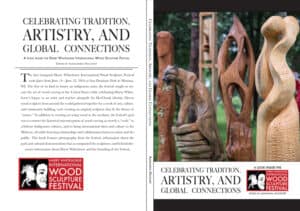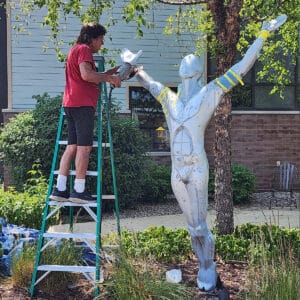REMEMBERING HARRY
A blog about Harry by Deb Whitehorse.
About Deb: Harry was married to the late Marlene Dreger for 35 years and they had 8 children. Marlene passed away in 1986. Harry and I were married for over 25 years and we have a daughter who has inherited her father’s love for art and works in a creative field. Harry led an incredible life and it’s important for those of us who knew him to tell his story. This is my way of sharing what he told me and what I observed during our time together.

The 2024 Harry Whitehorse International Wood Sculpture Festival Book is Here!
We’re thrilled to announce that the official book for the 2024 Harry Whitehorse International Wood Sculpture Festival is now available for purchase!
This captivating book explores the art and cultural impact of the inaugural bi-annual festival, created to celebrate the life and legacy of Ho-Chunk artist Harry Whitehorse. It highlights the talents of the Festival’s first group of wood sculptors who gathered to share and showcase their remarkable artistic visions.
- Edited by Alexandria Delcourt, the book features:
- High-quality professional photographs capturing the beauty of the sculptures, the opening and closing ceremonies, and cultural presenters.
- Includes insightful explanations from each artist, offering personal perspectives on their work and the creative processes behind their sculptures at the festival.
Behind-the-scenes stories showcasing the dedication and effort that brought the festival to life, capturing its unique magic.
Whether you’re an art enthusiast, cultural historian, or someone inspired by the connection between nature and artistic expression, this book is a must-read.
Thank you for supporting the Harry Whitehorse International Wood Sculpture Festival and helping us honor the legacy of a true master.
Warm regards,
The Festival Team
Asclepius, the Greek God of Healing
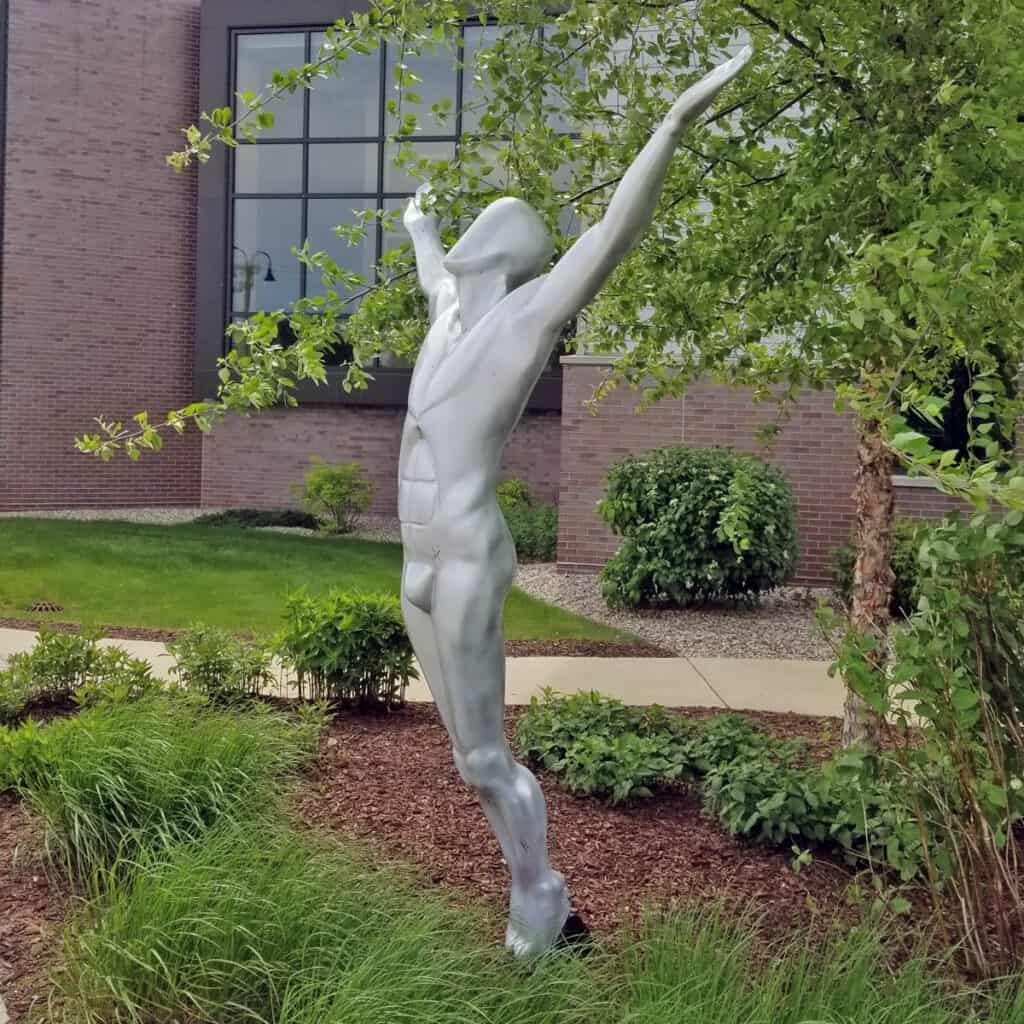
Asclepius, the Greek God of Healing by Harry Whitehorse at the Yahara Clinic in 2018.
Many have asked why Harry’s metal statue of Asclepius, the Greek God of Healing, at the Yahara Clinic in Monona, has been covered with a blue tarp for several months. Ken Whitehorse is repairing the sculpture. The sculpture has been restored several times over the years due to vandalism.
Doctors Gerald Derus and Richard Shropshire commissioned the sculpture for the Monona Grove Clinic in 1964, and it has been a presence in Monona, WI, ever since. The statue was first placed outside the Monona Drive clinic and later moved to the new UW Health Yahara Clinic on East Broadway, where it has also become a recognizable landmark.
The need for repairs goes back to the damage it sustained in the 1960s when vandals pried the statue from its base, pierced the metal with rocks or a hammer, and threw it in a dumpster. Despite Harry’s efforts to repair it by filling it with concrete and fixing the damaged metal, the effects of nature have taken their toll. The metal he used would have held up well if it weren’t for the vandalism.
Ken is doing a thorough restoration job, including incorporating carbon fiber material, which Harry would have approved.I’m thankful that UW Health Yahara Clinic valued the statue they inherited from the Monona Grove Clinic.
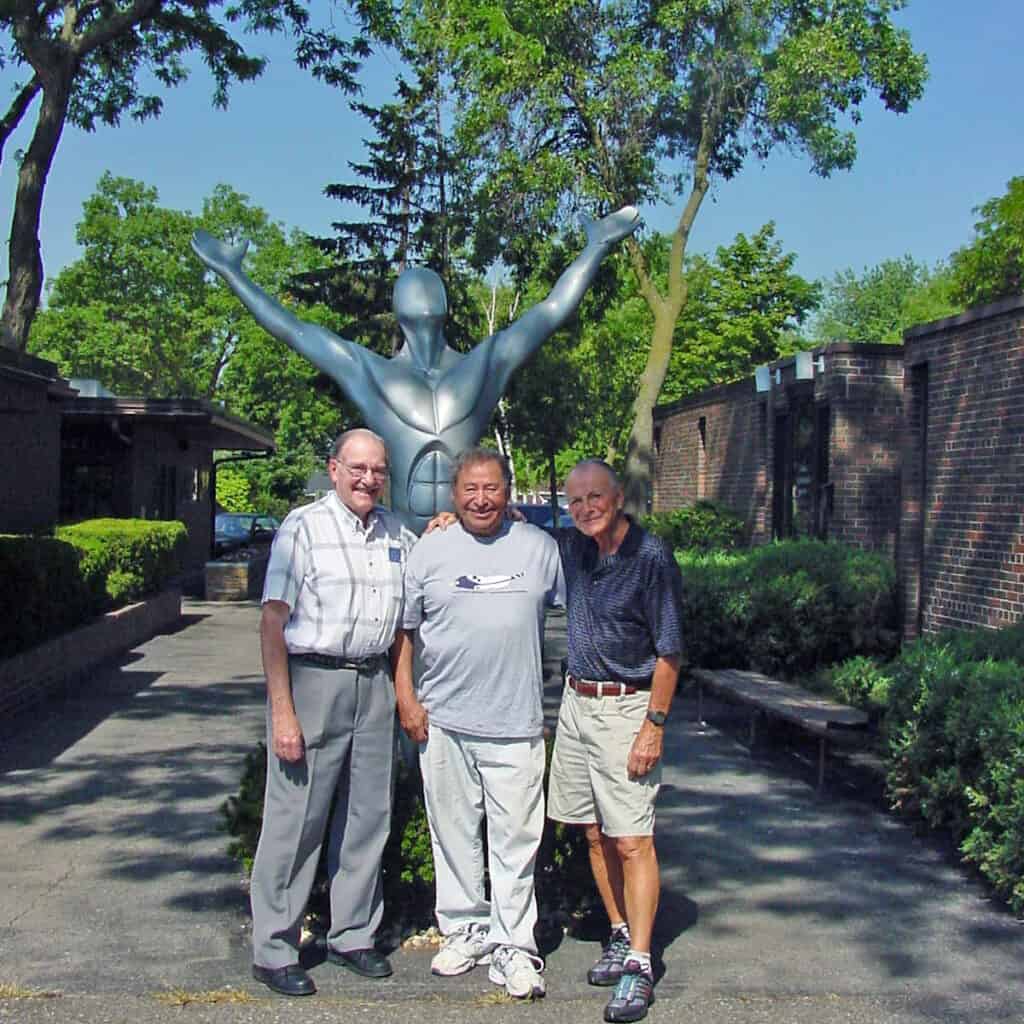
Dr. Richard Shropshire, Harry Whitehorse, and Dr. Gerald Derus at the Monona Grove Clinic, Monona, Wisconsin in 2005.
Harry Whitehorse International Sculpture Symposium – June 2024

EVENT WEB PAGE
Gene Delcourt is a Madison-based wood sculptor who Harry mentored.
Ken Whitehorse mentioned to me last year that Gene had proposed the idea of a wood sculpture symposium to honor Harry. This concept stayed with me, and in August 2022, I visited the San Damiano property on Lake Monona for the first time. When I saw the peaceful landscape, it became clear that it would be an ideal venue for Gene’s proposed event. Fortunately, Nancy Moore, a board member of Friends of San Damiano and Monona Alder, was present and agreed that the park would be an ideal location for the symposium. Gene, Nancy, and I organized a planning group and had our first meeting in the spring of 2023.
I want to express my appreciation for the fact that Harry is being honored in such a meaningful manner.
What to Know
Harry Whitehorse International Sculpture Symposium
Date: June 14 – 24, 2024
Location: San Damiano Park
4123 Monona Drive
Monona, WI 53716
Webpage
In the News: Indigenous Wisconsin Overture exhibit by Ho-Chunk artists tells many stories
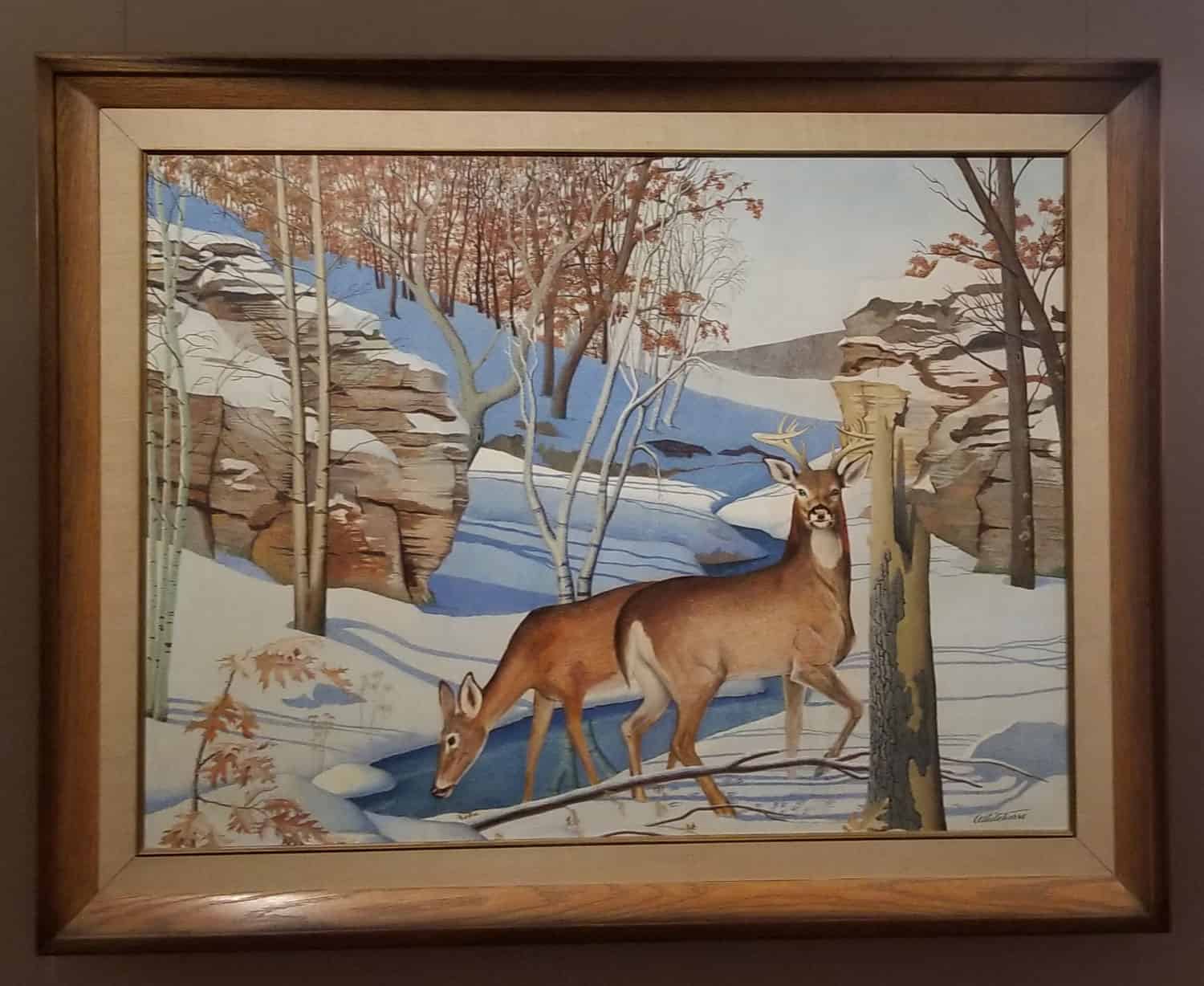
Oil on canvas by Harry Whitehorse
Isthmus
Indigenous Wisconsin
Overture exhibit by Ho-Chunk artists tells many storiesBY MICHAEL MUCKIAN
NOVEMBER 14, 2019
At a glance, the painting looks like many found hanging innocuously over sofas in living rooms throughout the Midwest. A pair of whitetail deer — a buck and doe — are captured in a wintery landscape framed by limestone escarpments that could represent Wisconsin’s Driftless Region, the scene’s long shadows indicating either the start or end of the animals’ day.Look more closely at “Untitled,” a 1985 oil-on-canvas work by the late Harry Whitehorse, and you will see how the artist’s use of pointillism, the impressionist technique of painting with distinct color dots, brings the sun-soaked image to life. Viewers might become transfixed by the buck’s stare, which reads as if unwanted visitors have interrupted his respite.
Continue reading.
In The News: Harry’s Bronze Badger
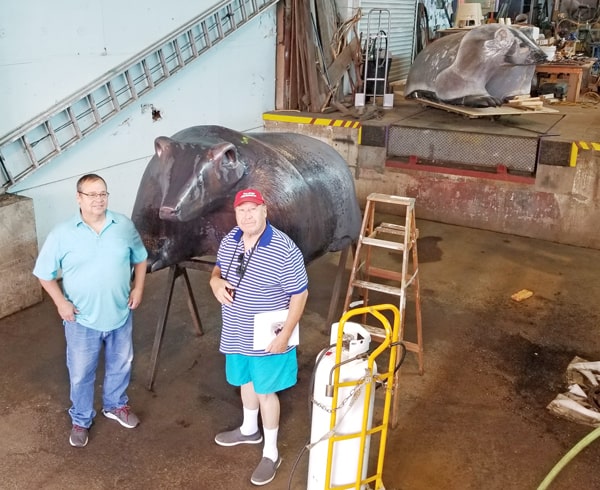
Harry’s sons, Greg and Gary Whitehorse, with the bronze Badger sculpture during the patination process at Vanguard Sculpture services in Milwaukee. Note the model in the background used to cast the bronze.
Bronze badger statue by Ho-Chunk artist Harry Whitehorse to be installed across from Camp Randall
Wisconsin State Journal
EMILY HAMER
A new Badger is coming to town this August.
Across the street from Camp Randall Stadium on Monroe Street, a 10-foot-long bronze statue of a badger — that people will be able to touch and sit on top of — is set to be installed Aug. 21.
Aptly called “The Badger,” the statue is a realistic likeness of the animal, rather than the more cartoonish look of University of Wisconsin mascot Bucky Badger. It has claws, a pointed nose, dark eyes and a fur texture cast in shiny bronze.
CONTINUE READING
Cars as Canvas: Making the Everyday Extraordinary
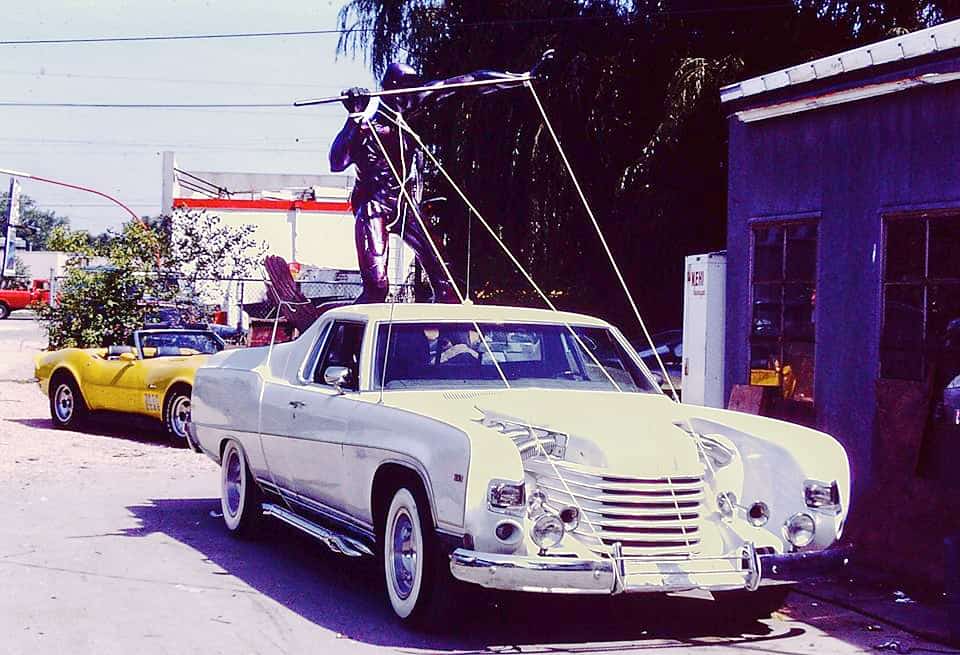
Two of Harry’s creations, a custom car carrying the sculpture “Fission Man”, c. 1970. Photo by Gary Whitehorse
Harry was fascinated by cars his entire life. One day when he was around 13, his uncle and mentor, George Seymour, told him that if he could drive his Ford Model T home, Harry could keep the car. Harry had never driven and couldn’t figure out how to shift the gears, so in his usual way, he adapted to the circumstances by driving the car to their home – in reverse.
Harry owned and operated Chief Auto Body for well over 30 years in Monona, Wisconsin. Throughout his life, Harry loved messing around with cars (and race cars, but that’s another story). He admired the Cord and customized an El Camino to look like one. Harry’s son Greg remembers, ” His custom cars were never meant to be ‘show’ cars. They were meant to be driven. Logged many miles on them. The “Cord” was a pickup truck (think El Camino-ish), and was used as a parts chaser for the body shop. The ‘57 Chevy was just fun to drive. Others I remember were; the “Rolls”, the pickup he made from the old Chrysler, the Pontiac dune buggy (which was ridiculous) and a bobbed VW Beetle. And the camper. May have been others.”
Sometime in the 1950s, Alex Jordan, the eccentric builder of House on the Rock, had Harry create a car on a truck chassis. Being the promoter that he was, Alex Jordan made up a fantastic story about that car – that he bought it from a royal prince or something like that. Harry is listed in the wiki Kustomrama, “the traditional rod and custom encyclopedia”.
Deb Whitehorse
The University of Wisconsin Arboretum Murals
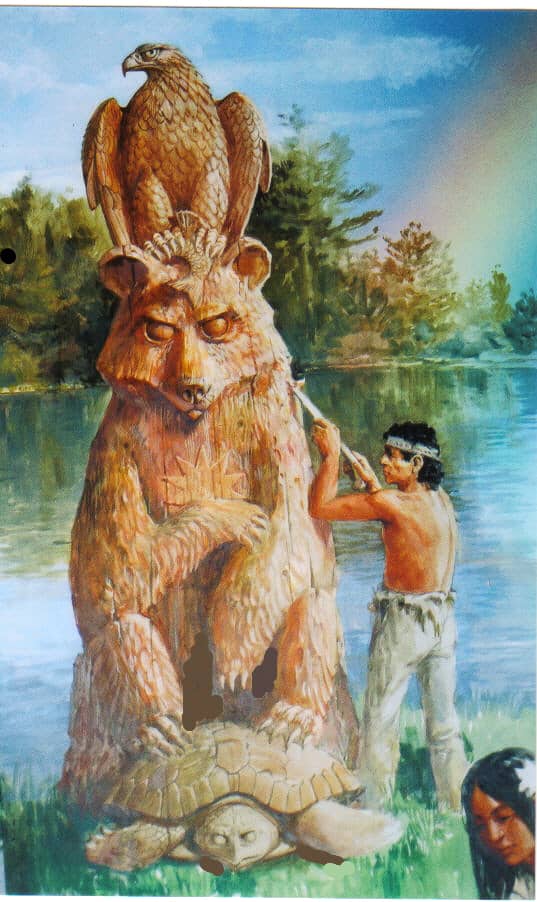
Detail of UW Madison Arboretum mural depiction of Harry Whitehorse by Viktor Bakhtin.
The next time you visit the UW Madison’s Arboretum, pay close attention to the murals located in the Visitor Center Orientation Theater created by the great Russian wildlife artist, Viktor Bakhtin. Viktor admired Harry’s work and was inspired to include him in the mural to honor Harry’s connection to the Four Lakes area. Harry was moved by Viktor’s paintings and recognized their mutual close relationship to nature.
I was thinking of Viktor’s visits to Harry and looked him up, discovering that sadly, Viktor passed on in 2016. Former UW Arboretum director Greg Armstrong suggested that Viktor Bakhtin create the murals. Greg wrote a heartfelt tribute to Viktor, “Remembering Viktor Bakhtin”, posted on the Arboretum’s website.
Among the people he consulted was Harry Whitehorse, a Ho-Chunk Nation artist, whose ancient ancestors built the mounds located at the Arboretum. Victor portrayed the First Nation’s relationship to the land from the time the glaciers receded more than 12,000 years ago. Read more.
I hadn’t thought of the murals in a long time. Harry’s influence and works were so numerous, it’s often too easy for me to forget the wonderful projects that always seemed to come his way.
Deb Whitehorse
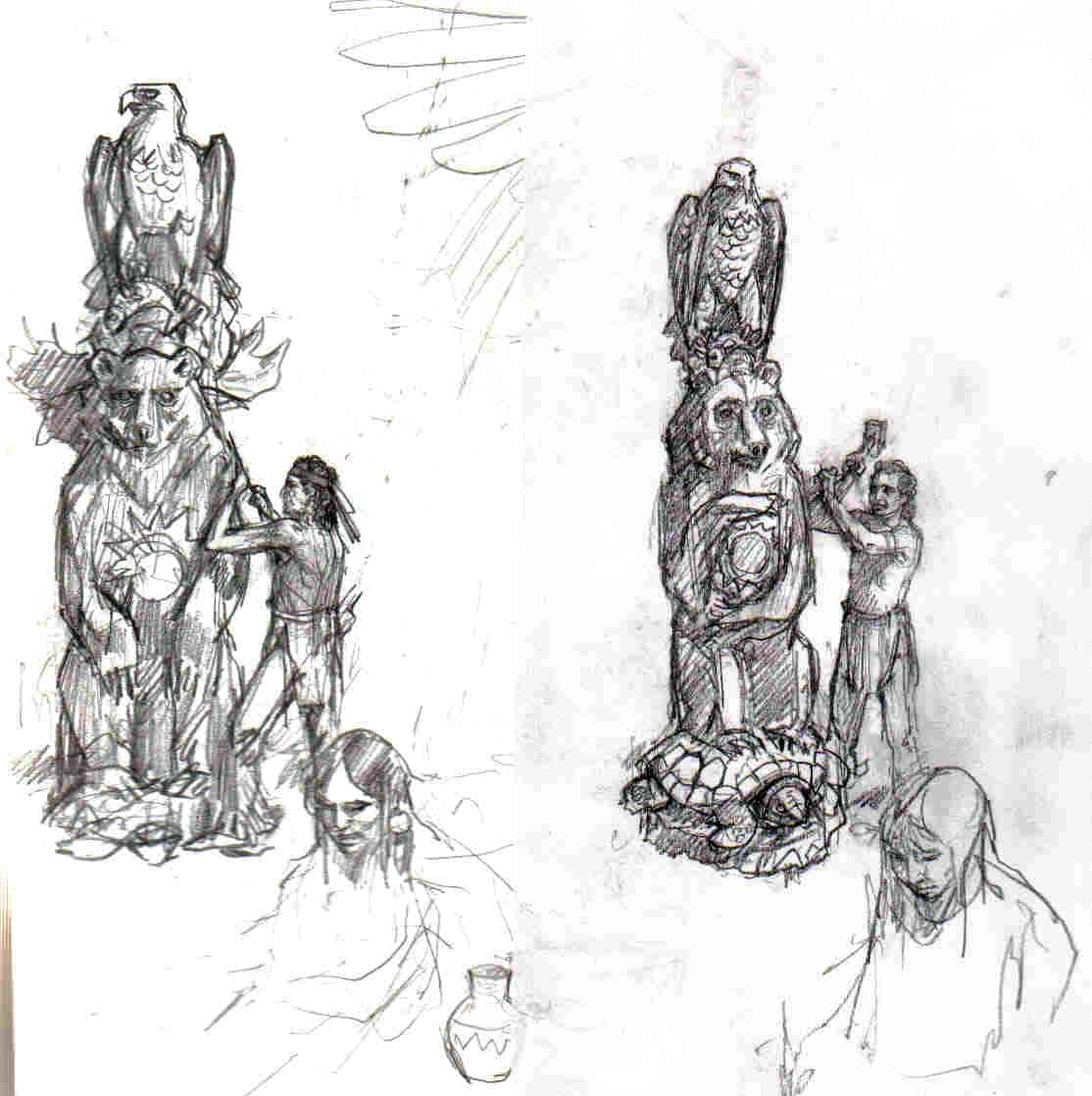
Working sketch of the mural by Viktor Bakhtin.
“Remembering Harry Whitehorse”
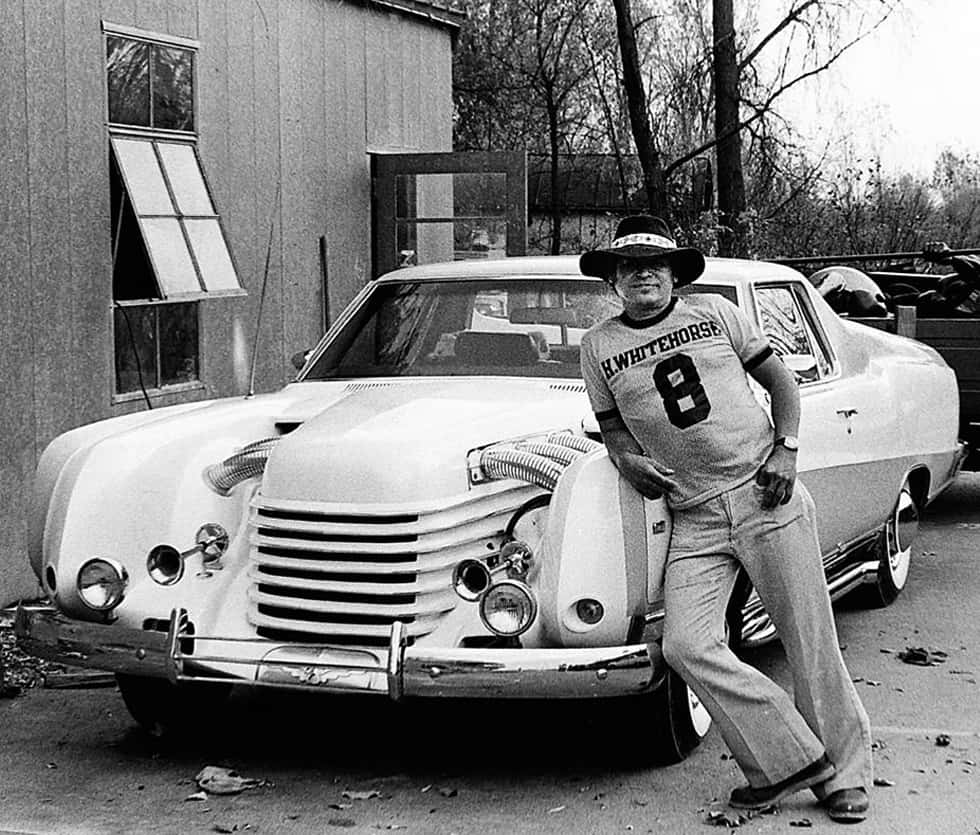 Madison 365
Madison 365
By Lawrence Andrea – Sep 18, 2018
Harry Whitehorse served and represented his community through his art.
Born into the Ho-Chunk tribe in a wigwam near the Indian Mission in Black River Falls in 1927, the now world-renowned sculptor and painter began his career in art locally as an apprentice to his uncle, an accomplished silversmith. Continue reading.
The Highground Celebrates 30 Years

This was one of the most meaningful commissions for Harry Whitehorse, as World War 2 Navy Veteran and Ho Chunk Nation tribal member.
A place of peace and healing, The Highground celebrates 30 years
BARRY ADAMS
Wisconsin State Journal
The park is home to the National Native American Vietnam Veterans Tribute dedicated in 1995 and bearing, in alphabetical order, the names of Native American troops from tribes around the country killed in Vietnam. They include Paul Pamanet, a private in the U.S. Army killed in action in 1968, and Martin Pamonicutt, a U.S. Marine killed in 1969. They are listed next to each other. Both were from the village of Neopit on the Menominee Reservation northwest of Green Bay.
Continue reading.
Photo Gallery
In The News: New public art a part of Monroe Street reconstruction
The Capital Times
By Abigail Becker
The small triangle-shaped parcel on Monroe Street unofficially known as Crazylegs Plaza will be home to a bronze sculpture of a badger designed by Madison artist Harry Whitehorse, who died in 2017.
